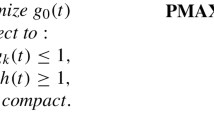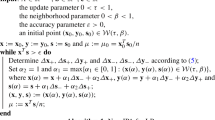Abstract
The paper presents an algorithm for solving nonlinear programming problems. The algorithm is based on the combination of interior and exterior point methods. The latter is also known as the primal-dual nonlinear rescaling method. The paper shows that in certain cases when the interior point method (IPM) fails to achieve the solution with the high level of accuracy, the use of the exterior point method (EPM) can remedy this situation. The result is demonstrated by solving problems from COPS and CUTE problem sets using nonlinear programming solver LOQO that is modified to include the exterior point method subroutine.
Similar content being viewed by others
References
H. Benson, D. Shanno, and R. Vanderbei, “Interior point methods for nonconvex nonlinear programming: filter methods and merit functions,” Technical Report ORFE-00-6, Dept. of ORFE, Princeton University, to appear in COAP.
A.S. Bondarenko, D.M. Bortz, and J.J. More, “COPS: Constrained optimization problems,” Mathematics and Computer Science Division, Argonne National Laboratory, http://www-unix.mcs.anl.gov/more/cops
I. Bongartz, A. Conn, N. Gould, and P. Toint, “CUTE: Constrained and unconstrained testing environment,” ACM Transactions on Mathematical Software, vol. 21, no. 1, pp. 123–160, 1993.
A. Fiacco and G. McCormick, “Nonlinear programming. sequential unconstrained minimization techniques,” SIAM Classic in Applied Mathematics, SIAM Philadelphia, PA, 1990.
R. Fletcher and S. Leyfer, “Nonlinear programming without a penalty function,” Mathematical Programming, vol. 91, no. 2, pp. 239–269, 2002.
P.E. Gill, W. Murray, M.A. Saunders, J.A. Tomlin, and M.H. Wright, “On projected Newton barrier method for linear programming and equivalence to Karmarkar's projective method,” Mathematical Programming, vol. 36, pp. 183–209, 1986.
I. Griva and R. Polyak, “Primal-dual nonlinear rescaling method with dynamic scaling parameter update,” Mathematical Programming (to appear).
B.W. Kort and D.P. Bertsekas, “Multiplier methods for convex programming,” in Proceedings IEEE Conference on Decision and Control, San Diego, California, pp. 428–432, 1973.
I. Lustig, R. Marsten, and D. Shanno, “Interior point methods for linear programming; computational state of the art,” ORSA Journal on Computing, vol. 6, pp. 1–14, 1994.
N. Megiddo, “Pathways to the optimal set in linear programming,” in Interior Point and Related Methods, N. Megiddo (Ed.), Ch. 8, Springer-Verlag: New York, 1989, pp. 131–158.
Ju.E. Nesterov and A.S. Nemirovsky, “Self-concordant functions and Polynomial-Time methods in Convex programming,” CEMI Academi of Sciences, Moscow 1989.
R. Polyak, “Modified barrier functions,” Mathematical Programming, vol. 54, pp. 177–222, 1992.
R. Polyak and M. Teboulle, “Nonlinear rescaling and Proximal-like methods in convex optimization,” Mathematical Programming, vol. 76, pp. 265–284, 1997.
R. Polyak, I. Griva, and J. Sobieski, “The Newton log-Sigmoid method in Constrained Optimization,” A Collection of Technical Papers, 7th AIAA/USAF/NASA/ISSMO Symposium on Multidisciplinary Analysis and Optimization vol. 3, 1998, pp. 2193–2201.
R. Polyak, “Nonlinear rescaling vs. smoothing technique in convex optimization,” Mathematical Programming, Ser. A, vol. 92, pp. 197–235, 2002.
R. Polyak and I. Griva, “Primal-dual nonlinear rescaling method for Convex Optimization,” SEOR Technical report SEOR-02-05, http://www.princeton.edu/ igriva/papers.html to appear in JOTA.
J. Renegar and M. Shub, “Unified complexity analysis for Newton LP methods,” Technical Report No. 807, School of Operations Research and Industrial Engineering, College of Engineering, Cornell University, Ithaca, NY, 1988.
R. Vanderbei, “Symmetric quasidefinite matrices,” SIAM Journal on Optimization, vol. 5, no. 1, pp. 100–113, 1995.
R.J. Vanderbei and D.F. Shanno, “An interior-point algorithm for nonconvex nonlinear programming,” COAP, vol. 13, pp. 231–252, 1999.
R.J. Vanderbei, “LOQO: An interior point code for quadratic programming,” Optimization Methods and Software, vol. 12, pp. 451–484, 1999.
R.J. Vanderbei, “LOQO user's manual—version 3.10,” Optimization Methods and Software, vol. 12, pp. 485–514, 1999.
S. Wright, Primal-dual interior points methods, SIAM, 1997.
Author information
Authors and Affiliations
Rights and permissions
About this article
Cite this article
Griva, I. Numerical Experiments with an Interior-Exterior Point Method for Nonlinear Programming. Computational Optimization and Applications 29, 173–195 (2004). https://doi.org/10.1023/B:COAP.0000042029.73199.83
Issue Date:
DOI: https://doi.org/10.1023/B:COAP.0000042029.73199.83




